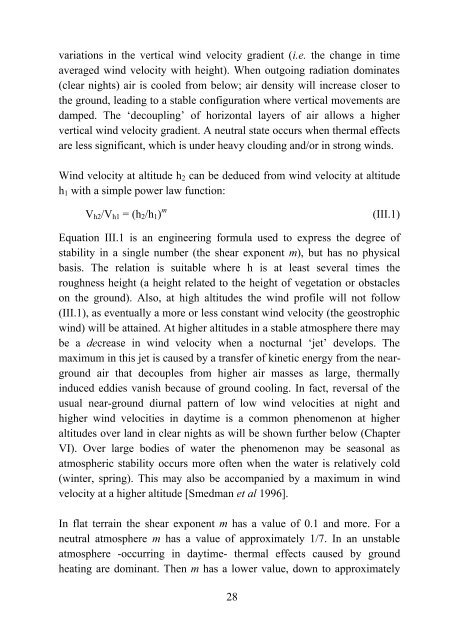The sounds of high winds
The sounds of high winds
The sounds of high winds
You also want an ePaper? Increase the reach of your titles
YUMPU automatically turns print PDFs into web optimized ePapers that Google loves.
variations in the vertical wind velocity gradient (i.e. the change in time<br />
averaged wind velocity with height). When outgoing radiation dominates<br />
(clear nights) air is cooled from below; air density will increase closer to<br />
the ground, leading to a stable configuration where vertical movements are<br />
damped. <strong>The</strong> ‘decoupling’ <strong>of</strong> horizontal layers <strong>of</strong> air allows a <strong>high</strong>er<br />
vertical wind velocity gradient. A neutral state occurs when thermal effects<br />
are less significant, which is under heavy clouding and/or in strong <strong>winds</strong>.<br />
Wind velocity at altitude h 2 can be deduced from wind velocity at altitude<br />
h 1 with a simple power law function:<br />
V h2 /V h1 = (h 2 /h 1 ) m<br />
(III.1)<br />
Equation III.1 is an engineering formula used to express the degree <strong>of</strong><br />
stability in a single number (the shear exponent m), but has no physical<br />
basis. <strong>The</strong> relation is suitable where h is at least several times the<br />
roughness height (a height related to the height <strong>of</strong> vegetation or obstacles<br />
on the ground). Also, at <strong>high</strong> altitudes the wind pr<strong>of</strong>ile will not follow<br />
(III.1), as eventually a more or less constant wind velocity (the geostrophic<br />
wind) will be attained. At <strong>high</strong>er altitudes in a stable atmosphere there may<br />
be a decrease in wind velocity when a nocturnal ‘jet’ develops. <strong>The</strong><br />
maximum in this jet is caused by a transfer <strong>of</strong> kinetic energy from the nearground<br />
air that decouples from <strong>high</strong>er air masses as large, thermally<br />
induced eddies vanish because <strong>of</strong> ground cooling. In fact, reversal <strong>of</strong> the<br />
usual near-ground diurnal pattern <strong>of</strong> low wind velocities at night and<br />
<strong>high</strong>er wind velocities in daytime is a common phenomenon at <strong>high</strong>er<br />
altitudes over land in clear nights as will be shown further below (Chapter<br />
VI). Over large bodies <strong>of</strong> water the phenomenon may be seasonal as<br />
atmospheric stability occurs more <strong>of</strong>ten when the water is relatively cold<br />
(winter, spring). This may also be accompanied by a maximum in wind<br />
velocity at a <strong>high</strong>er altitude [Smedman et al 1996].<br />
In flat terrain the shear exponent m has a value <strong>of</strong> 0.1 and more. For a<br />
neutral atmosphere m has a value <strong>of</strong> approximately 1/7. In an unstable<br />
atmosphere -occurring in daytime- thermal effects caused by ground<br />
heating are dominant. <strong>The</strong>n m has a lower value, down to approximately<br />
28
















